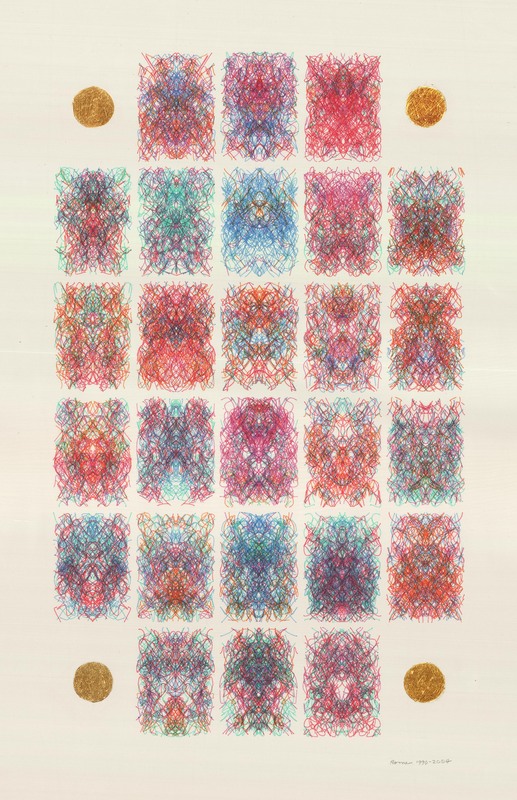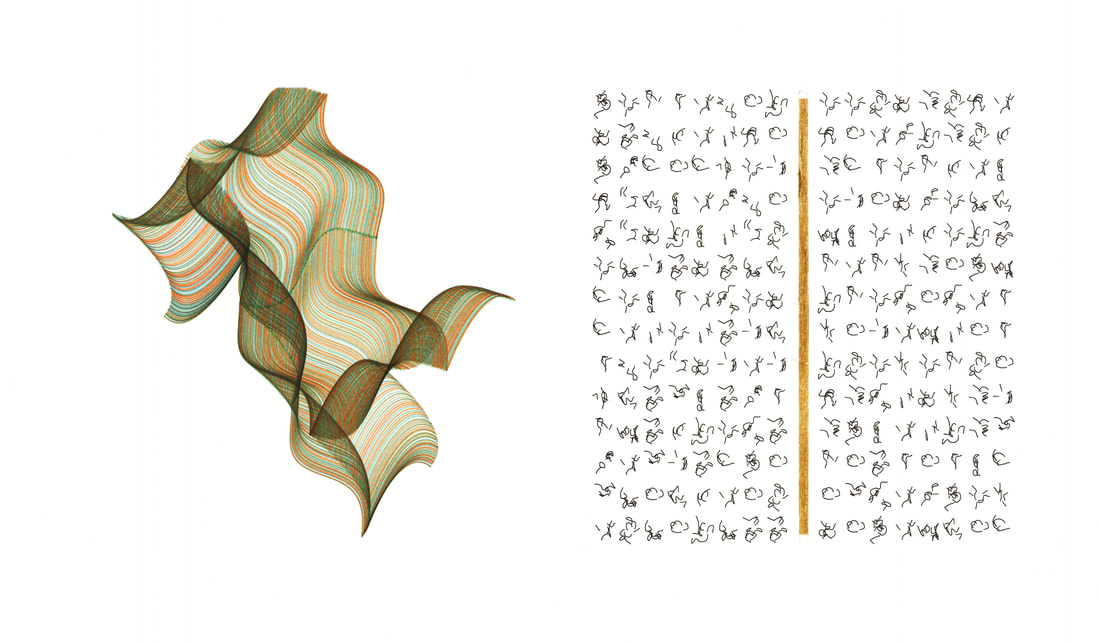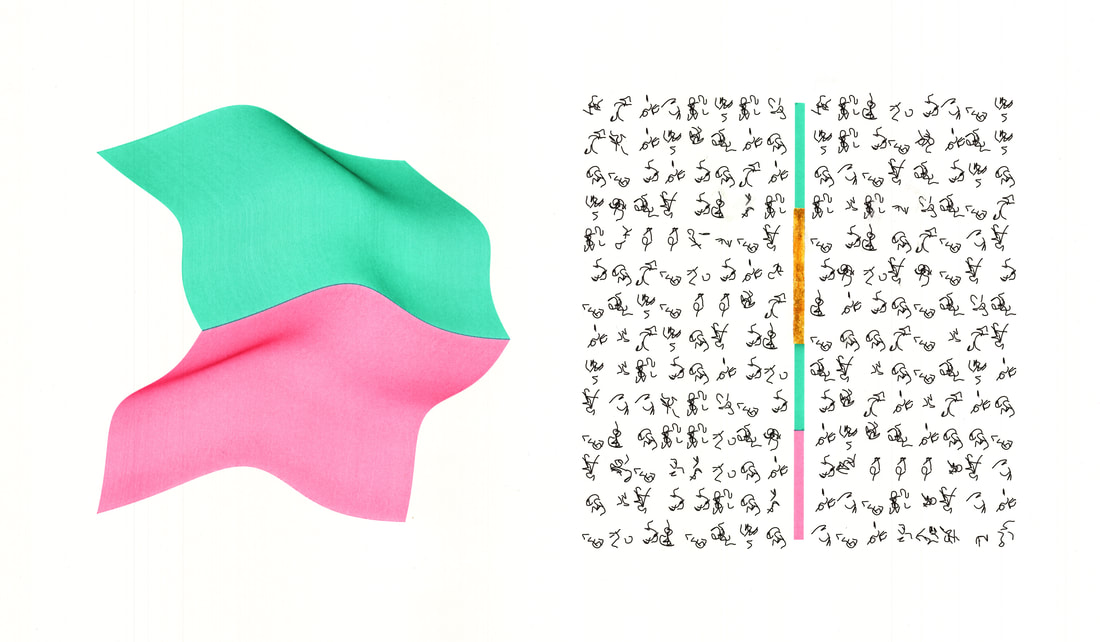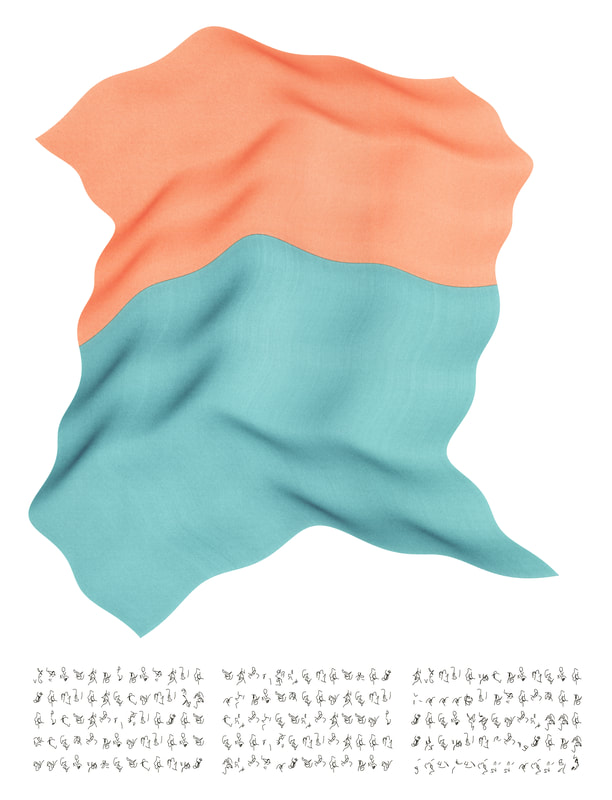Icons of the Digital Age
For me this was the new scripture, opening up areas of visual form and knowledge that weren’t accessible to us before. . . . I saw them as a form of revelation.
|
Verostko, Star Tribune, 2014
|
Verostko’s studio archives include a film he made in 1969 at UNIVAC showing an algorithmically generated cube spiraling to infinity. He coupled this film with electronic music for a public television presentation where he compared the emerging new media with medieval manuscript illumination. He envisioned how emerging electronic technology would become an art medium in our times similar to medieval manuscript illumination in its time.
By the end of the 1980s, Verostko came to view his studio as an “electronic scriptorium” with a network of electronic scribes. The “scribe” is essentially a personal expert system consisting of a multi-pen plotter coupled to a PC driven by original drawing instructions coded by Verostko. Before inkjet and laser technology, pen plotters were the drawing machines commonly used in architecture and engineering offices. With its drawing arm choosing from a bank of technical pens loaded with acrylic inks, the scribe literally “grows” visual forms by carrying out Verostko’s instructions and drawing each line precisely on rag papers. Occasionally, using brushes adapted to fit its drawing arm, the scribe executes paint strokes.
Hodos, the title that Verostko gave his software, means “path” or “road” in Greek. The algorithms in Hodos describe “paths” that are the “method” for achieving the painting. Hodos as the “path” or the “way” is the Western equivalent of the Chinese term Dao (Tao), a key concept in ancient Chinese wisdom. The strokes follow whatever path the chaotic system makes. Whatever way unfolds in the context is just fine. A simple routine, similar to tossing dice, initiates the path. From then on, the process has a remarkable life of its own following its own unique way.
Verostko’s interest in manuscript illumination led to various formats that appear in his Hodos Correspondence, Diamond Lake Apocalypse series, the Badland Scrolls, and the Ezekiel series. They feature glyphic texts that mime the visual qualities of language without being one (this is also referred to as “asemic” writing). Later, in the 1990s, Verostko built a code routine for generating characters assigned to an alphabet. Texts were then presented in artworks with characters that could be translated, such as his Flowers of Learning, the Rocktown Scrolls, and most of the Pearl Park Scriptures.
By the end of the 1980s, Verostko came to view his studio as an “electronic scriptorium” with a network of electronic scribes. The “scribe” is essentially a personal expert system consisting of a multi-pen plotter coupled to a PC driven by original drawing instructions coded by Verostko. Before inkjet and laser technology, pen plotters were the drawing machines commonly used in architecture and engineering offices. With its drawing arm choosing from a bank of technical pens loaded with acrylic inks, the scribe literally “grows” visual forms by carrying out Verostko’s instructions and drawing each line precisely on rag papers. Occasionally, using brushes adapted to fit its drawing arm, the scribe executes paint strokes.
Hodos, the title that Verostko gave his software, means “path” or “road” in Greek. The algorithms in Hodos describe “paths” that are the “method” for achieving the painting. Hodos as the “path” or the “way” is the Western equivalent of the Chinese term Dao (Tao), a key concept in ancient Chinese wisdom. The strokes follow whatever path the chaotic system makes. Whatever way unfolds in the context is just fine. A simple routine, similar to tossing dice, initiates the path. From then on, the process has a remarkable life of its own following its own unique way.
Verostko’s interest in manuscript illumination led to various formats that appear in his Hodos Correspondence, Diamond Lake Apocalypse series, the Badland Scrolls, and the Ezekiel series. They feature glyphic texts that mime the visual qualities of language without being one (this is also referred to as “asemic” writing). Later, in the 1990s, Verostko built a code routine for generating characters assigned to an alphabet. Texts were then presented in artworks with characters that could be translated, such as his Flowers of Learning, the Rocktown Scrolls, and most of the Pearl Park Scriptures.
Echoes from the Cloister
Echoes from the Cloister, 1968–69, algorithmic animation, 6:08 min., created on Univac computer
Shortly after arriving in Minnesota to teach at MCAD, I was invited to give one of a series of public television presentations featuring the cultural contributions of the Benedictine monks at St. John’s Abbey in Collegeville, Minnesota. My 1969 lecture addressed the manuscript illuminations in the then recently established microfilm collection of medieval manuscripts located in the Hill Manuscript Library at St. John’s University.
To introduce the medieval illuminations, I included a brief, thirty-second algorithmic animation. The electronic sequence from Echoes from the Cloister provided a provocative lead into the subject matter. "If the monks were living today," I noted, "they would be exploring this new media for illuminating their most treasured texts."
To introduce the medieval illuminations, I included a brief, thirty-second algorithmic animation. The electronic sequence from Echoes from the Cloister provided a provocative lead into the subject matter. "If the monks were living today," I noted, "they would be exploring this new media for illuminating their most treasured texts."
Verostko
Twenty-Six Visions of Hildegarde, 2002, pen and ink plotter drawing with hand-applied gold leaf, 22 1/4 x 30 in.
Hildegarde of Bingen (1098–1179), a medieval theologian and mystic, organized her major prophetic work, Scivias, around twenty-six visions divided in three parts. These twenty-six pen plotted “visions of Hildegarde” invite meditation through arrays of improvisation. Each vision points to the manner in which the limits of the drawing procedure, like life, are unknowable.
Hildegarde of Bingen (1098–1179), a medieval theologian and mystic, organized her major prophetic work, Scivias, around twenty-six visions divided in three parts. These twenty-six pen plotted “visions of Hildegarde” invite meditation through arrays of improvisation. Each vision points to the manner in which the limits of the drawing procedure, like life, are unknowable.
Diamond Lake Apocalypse series
Diamond Lake Apocalypse, #888n, 1992
Diamond Lake Apocalypse, #222n, 1992
pen, ink, and brush plotter drawing with hand- applied gold leaf
Diamond Lake Apocalypse, #222n, 1992
pen, ink, and brush plotter drawing with hand- applied gold leaf
Each of these examples includes a pair of symmetrical brush strokes. The control points for the strokes in each work also control every pen stroke found in that work. This procedure introduces a “self-similarity” that permeates each work somewhat like a “genetic” marker.
The term “apocalypse” (ἀποκάλυψις apokálypsis) has its roots in a Greek term that literally means “lifting of the veil,” a kind of “revelation.” In the Christian West, it generally refers to the Last Gospel of John, the “Apocalypse,” foretelling the coming of “the end of time.” More broadly an “apocalypse” may be viewed as a revelation of things to come.
The term “apocalypse” (ἀποκάλυψις apokálypsis) has its roots in a Greek term that literally means “lifting of the veil,” a kind of “revelation.” In the Christian West, it generally refers to the Last Gospel of John, the “Apocalypse,” foretelling the coming of “the end of time.” More broadly an “apocalypse” may be viewed as a revelation of things to come.
Verostko
Ezekiel series: Vision 2, 1993, pen, ink, and brush plotter drawing with hand-applied gold leaf
The Flowers of Learning: Hortus Conclusus Nazarenus
In 2006, Verostko installed a seven-panel mural of original pen and ink drawings at the Spalding University Academic Center in Louisville, Kentucky. The murals memorialize seven accomplished educators who taught at the college while Alice, Verostko’s wife, was a student. (She graduated in 1941 when the institution was then named Nazareth College.) Each of the drawings features a colorful “cyberflower” and includes a quotation drawn from a significant cultural or literary figure in world history.
As installed at Spalding University, framed within a larger frame, the flowers are presented as a hortus conclusus, an enclosed garden. As such, Verostko intended them to “embrace the highest aspirations symbolized in gardens of many cultures—a paradise of peace and tranquility, the Garden of Eden, a utopia of brotherhood, sisterhood, and wellbeing—the place we seek, yet a place of fullness beyond our reach that beckons us to reach ever higher.” And in keeping with the value that both Verostko and Alice placed on education throughout their lives, in the accompanying catalog Verostko writes, “The garden honors those at Spalding University, past and present, who have dedicated their lives, as teachers, to help us acquire the tools for our journey.”
|
Flowers of Learning: Black Elk, 2006, pen and ink plotter drawing
|
Text translation: Then I was standing on the highest mountain of them all and around that made one circle, wide as daylight and as starlight, and in the center grew one mighty flowering tree to shelter all the children of one mother and one father. – Black Elk
Text source: John G. Neihardt, Black Elk Speaks: The Life Story of a Holy Man of the Oglala Sioux [1932]. Quoted from chapter 3, “The Great Vision.” |
Each of the glyph-like characters is a letter clothed in linear forms created for the project. Algorithms for creating the alphabet were similar to those used for the flower forms.
Pearl Park Scriptures
Pearl Park Scripture, O, Tao Te Ching, 2005
pen and ink plotter drawing
Text format: Nine characters per line, fourteen lines per column, two columns.
Text translation: So it is that existence and non-existence give birth the one to (the idea of) the other; that difficulty and ease produce the one the other – that height and lowness arise from the contrast of the one with the other; that musical notes and tones become harmonious through the relation of one with another.
Text source: Lao-Tzu, Tao Te Ching, English translation by James Legge
(Sacred Books of the East, vol. 39, 1891).
pen and ink plotter drawing
Text format: Nine characters per line, fourteen lines per column, two columns.
Text translation: So it is that existence and non-existence give birth the one to (the idea of) the other; that difficulty and ease produce the one the other – that height and lowness arise from the contrast of the one with the other; that musical notes and tones become harmonious through the relation of one with another.
Text source: Lao-Tzu, Tao Te Ching, English translation by James Legge
(Sacred Books of the East, vol. 39, 1891).
Pearl Park Scripture, D, 2004
pen and ink plotter drawing with hand-applied gold leaf
Text format: Eight glyphs per line, fourteen lines per column, two columns.
Text translation: Non-rational glyph sequence
pen and ink plotter drawing with hand-applied gold leaf
Text format: Eight glyphs per line, fourteen lines per column, two columns.
Text translation: Non-rational glyph sequence
Pearl Park Scripture, Galileo, 2004–05, pen and ink plotter drawing with hand-applied gold leaf
Text format: Eight characters per line, fourteen lines per column, two columns.
Text translation: Philosophy is written in this grand book—I mean the universe —which stands continually opened to our gaze, but it cannot be understood unless one first learns to comprehend the language and interpret the characters in which it is written. — Galileo Galilei, 1623.
Text source: Galileo Galilei, Il Saggiatore, 1603.
Text format: Eight characters per line, fourteen lines per column, two columns.
Text translation: Philosophy is written in this grand book—I mean the universe —which stands continually opened to our gaze, but it cannot be understood unless one first learns to comprehend the language and interpret the characters in which it is written. — Galileo Galilei, 1623.
Text source: Galileo Galilei, Il Saggiatore, 1603.
Rocktown Scrolls
Rocktown Scroll: Shakespeare, 2006, pen and ink plotter drawing
Text translation:
I know a bank where the wild thyme blows,
Where oxlips and the nodding violet grows,
Quite over-canopied with luscious woodbine,
With sweet musk-roses and with eglantine.
Text source: William Shakespeare, A Midsummer Night’s Dream (2.1.255-258)
Text translation:
I know a bank where the wild thyme blows,
Where oxlips and the nodding violet grows,
Quite over-canopied with luscious woodbine,
With sweet musk-roses and with eglantine.
Text source: William Shakespeare, A Midsummer Night’s Dream (2.1.255-258)
The Rocktown Scrolls are named for the Pennsylvania coalfield “patch” where Verostko grew up “dreaming wondrous dreams while sliding down the ash-dumps.” They present colorful algorithmic drawings accompanied with passages selected from a wide range of literature and culture. The passages are written with algorithmically- generated glyphs clothing the alphabet with a unique set of linear forms. These coded glyph forms invite viewers to ponder the nature of language while the larger, colored forces may be savored as cyber flowers floating in unbounded space.
Cyberflower Blue, 2002, pen and ink plotter drawing, 23 x 29 in
Algorithmic Poetry, Tumbleweed, 2010, brush, ink, and acrylic plotter drawing, 22 x 29 1/2 in.














